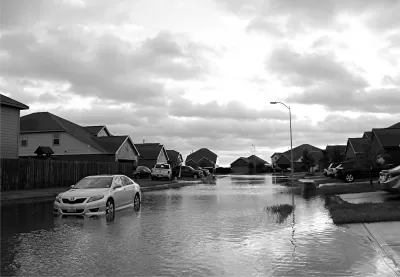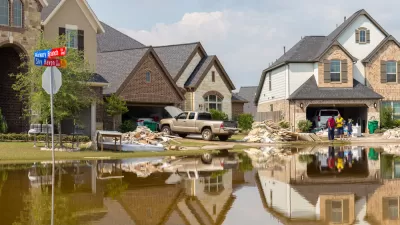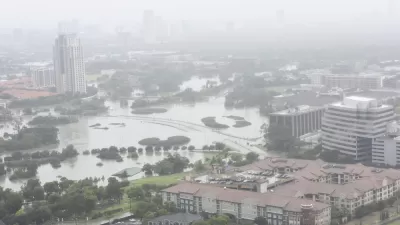Having charged low rates during years of bumper development, the National Flood Insurance Program worked at cross-purposes with itself while development continued on.

Drawing from a segment of Vox's "The Weeds," Kelly Swanson writes, "The national flood insurance program was created in the 1960s to deter people from building in flood prone areas. But, says Sarah [Kliff], it has actually done the opposite."
"[Matthew Yglesias] offers an explanation as to why representatives from flood-prone areas support the federal flood insurance program — the cheap land has promoted economic growth." Charging low premiums in what were actually high-risk areas did little to curtail development there. And when the floods came, money was available to bail the most risky homes out.
Eager for development, local politicians supported the program. Says Yglesias, "It was the politicians in these areas that did not really want to accept the market verdict, that it may seem like the city of Houston is surrounded by cheap land, but that land has enormous hidden flooding risk."
FULL STORY: The Weeds: the problem with the national flood insurance program

Alabama: Trump Terminates Settlements for Black Communities Harmed By Raw Sewage
Trump deemed the landmark civil rights agreement “illegal DEI and environmental justice policy.”

Study: Maui’s Plan to Convert Vacation Rentals to Long-Term Housing Could Cause Nearly $1 Billion Economic Loss
The plan would reduce visitor accommodation by 25% resulting in 1,900 jobs lost.

Why Should We Subsidize Public Transportation?
Many public transit agencies face financial stress due to rising costs, declining fare revenue, and declining subsidies. Transit advocates must provide a strong business case for increasing public transit funding.

Wind Energy on the Rise Despite Federal Policy Reversal
The Trump administration is revoking federal support for renewable energy, but demand for new projects continues unabated.

Passengers Flock to Caltrain After Electrification
The new electric trains are running faster and more reliably, leading to strong ridership growth on the Bay Area rail system.

Texas Churches Rally Behind ‘Yes in God’s Back Yard’ Legislation
Religious leaders want the state to reduce zoning regulations to streamline leasing church-owned land to housing developers.
Urban Design for Planners 1: Software Tools
This six-course series explores essential urban design concepts using open source software and equips planners with the tools they need to participate fully in the urban design process.
Planning for Universal Design
Learn the tools for implementing Universal Design in planning regulations.
Caltrans
Smith Gee Studio
Institute for Housing and Urban Development Studies (IHS)
City of Grandview
Harvard GSD Executive Education
Toledo-Lucas County Plan Commissions
Salt Lake City
NYU Wagner Graduate School of Public Service





























